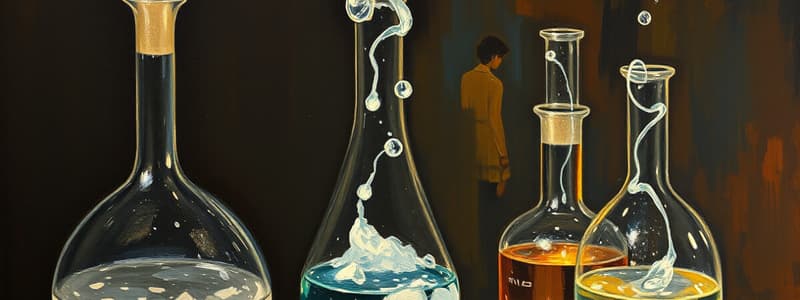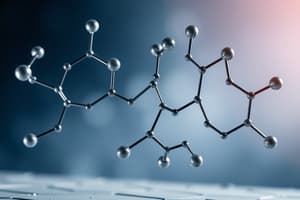Podcast
Questions and Answers
What is the purpose of separating and/or purifying organic substances?
What is the purpose of separating and/or purifying organic substances?
To isolate specific compounds from mixtures and remove impurities.
What does the term 'solid-liquid extraction' refer to?
What does the term 'solid-liquid extraction' refer to?
- Extraction of gas from liquid mixtures
- Separation of solids based on particle size
- Separation of a solid from a liquid using filtration
- Recovery of soluble components from a solid matrix (correct)
The formula for the Distribution (Partition) Coefficient is: Kp = solubility of A in O.P. (g/mL) / solubility of A in __________ (g/mL).
The formula for the Distribution (Partition) Coefficient is: Kp = solubility of A in O.P. (g/mL) / solubility of A in __________ (g/mL).
A.P.
Solid-liquid extraction involves the solvent being heated if water is used as the extracting solvent.
Solid-liquid extraction involves the solvent being heated if water is used as the extracting solvent.
What are the three main factors in the extraction process?
What are the three main factors in the extraction process?
Which of the following is NOT a property of a good extracting solvent?
Which of the following is NOT a property of a good extracting solvent?
What is the recommended number of extractions to achieve sufficient analyte recovery?
What is the recommended number of extractions to achieve sufficient analyte recovery?
What is the principle behind recrystallization?
What is the principle behind recrystallization?
Flashcards are hidden until you start studying
Study Notes
Separation and Purification Techniques
- Separation and purification of organic compounds are essential for isolating desired compounds from mixtures.
- Key methods include solution and filtration, extraction, recrystallization, and sublimation.
Solution and Filtration
- Solid-liquid extraction principle: based on relative solubility of components.
- Solvent for two-component mixtures must allow one component (solute) to be completely soluble while the other remains insoluble.
- Soluble component recovery involves evaporating the solvent from the filtrate.
- Insoluble components are retained on filter paper.
Extraction
- A fundamental technique for separating compounds based on their solubility in two immiscible phases (liquid-liquid or liquid-solid).
- Distribution (Partition) Coefficient (Kp) is defined as the solubility of compound A in organic phase divided by its solubility in aqueous phase.
Solid-Liquid Extraction
- Involves extracting the analyte from a solid matrix into a solvent where it is soluble.
- Can be performed by heating the solid in water or using a Soxhlet extractor for organic solvents.
Liquid-Liquid Extraction
- Also referred to as solvent extraction, separates compounds based on solubilities in two immiscible liquids.
- Commonly executed during work-up processes post-chemical reactions.
Simple Extraction
- Manual execution using a separatory funnel, involving vigorous shaking to enhance contact between phases.
- Distinct layers are formed, allowing denser liquids to be drawn off.
- Factors affecting successful extraction include solvent selection and extraction efficiency.
Solvent Selection
- An effective extracting solvent should be practically immiscible with the target solution, have a low boiling point for easy removal, and exhibit a high distribution coefficient for the solute.
- The solvent must also be chemically inert towards the sample matrix.
Common Extraction Solvents
- Available solvents and their properties include:
- Diethyl ether: Boiling Point 35°C, 6 g/100mL in water, Density 0.71
- Pentane: Boiling Point 36°C, 0.04 g/100mL in water, Density 0.62
- Dichloromethane: Boiling Point 40°C, 2 g/100mL in water, Density 1.32
- Chloroform: Boiling Point 61°C, 0.5 g/100mL in water, Density 1.48
Extraction Efficiency
- Multiple extractions are more effective for recovering analytes, typically involving three to four extractions with minimal solvent.
- The distribution coefficient governs the partitioning of the analyte between two phases.
Recrystallization
- A technique used to purify solid products from organic reactions, essential for achieving high purity levels.
- Most organic compounds exhibit higher solubility in hot solvents compared to cold solvents.
- Impurities generally possess different solubility profiles than desired compounds, aiding in separation.
Procedure of Recrystallization
- Selection of a suitable solvent is crucial for recrystallization effectiveness.
- A good solvent should selectively dissolve the desired compound while allowing impurities to remain insoluble upon cooling.
Studying That Suits You
Use AI to generate personalized quizzes and flashcards to suit your learning preferences.




